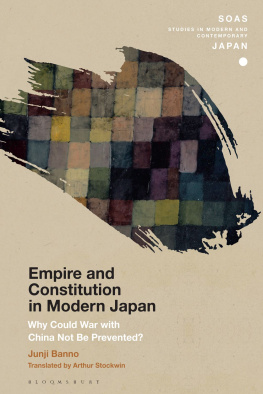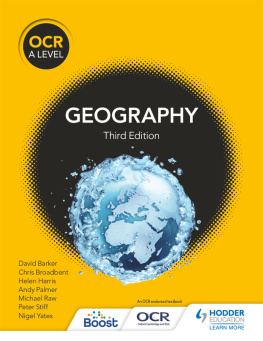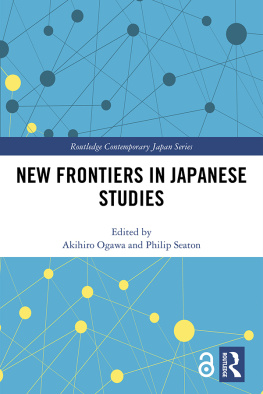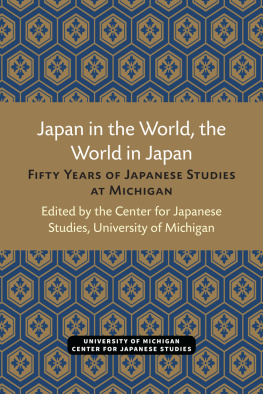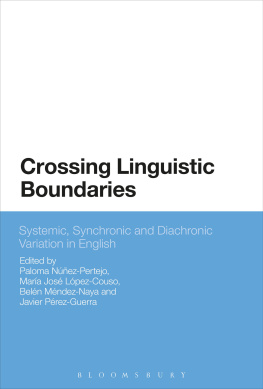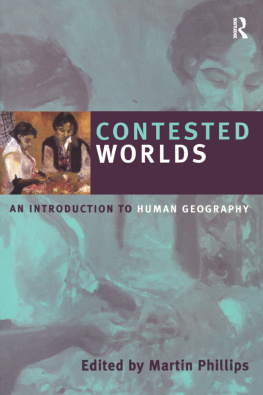GEOGRAPHICAL STUDIES AND JAPAN
First published 1993 by
JAPAN LIBRARY
Published 2013 by Routledge
2 Park Square, Milton Park, Abingdon, Oxon OX14 4RN
711 Third Avenue, New York, NY, 10017, USA
Routledge is an imprint of the Taylor & Francis Group, an informa business
Anglo-Japanese Geographical Seminar
All rights reserved. No part of this publication may be reproduced or transmitted, in any form or by any means, without permission.
British Library Cataloguing in Publication Data
A CIP catalogue record for this book is available from the British Library
ISBN 13: 978-1-873-41015-8 (hbk)
ISBN 13: 978-1-873-41019-6 (pbk)
This short book is not a survey of the geography of Japan, nor is it for the most part an account of how professional geographers - Japanese and others - have interpreted the geography of Japan. Rather, it is meant as a record of a conference, the first of its kind ever held in the U.K., that brought together some 20 Japanese geographers and a roughly equal number of British colleagues for purposes of considering and discussing geographical topics of mutual interest. The conference was held in the summer of 1988 at three successive locations: the School of Oriental and African Studies (University of London), the University of Sheffield, and the University of Durham. At each of these centres, a full day was devoted to the formal presentation of academic papers by Japanese and British geographers, and, since one of the objectives of the exercise was to afford Japanese colleagues with an opportunity to observe at first hand some of the changes currently under way in the English landscape, two days were given over to field excursions - to locations as varied as the London docklands, the Don valley, and the Beamish industrial museum in County Durham.
Following Japanese conventions, the conference was called a seminar, and indeed the discussions that followed the presentation of papers were often of the lively, informative and amiably contentious kind that one would expect of a good university seminar. English colleagues who attended the seminar learned much about the research vigour and breadth of interest that characterises geography in contemporary Japan; our Japanese colleagues, while sometimes uneasy about the formal aspects of the seminars proceedings and occasionally a little baffled by the English predilection for concentrating on the past rather than the present, gained valuable insights into the world of professional geography in Britain and observed with interest the changing English landscape, whether via the excursions or from the windows of the long-distance coaches that transported them from one venue to another.
For purposes of providing a complete record of the 1988 seminar, brief descriptions of the excursions are given at the end of the book - these descriptions will perhaps serve to remind our Japanese colleagues of visits to the field that, we hope, were both enjoyable and instructive. But the main business of the seminar, and by far its most valuable component, was the presentation of the academic papers, and it is these papers that make up most of this book. All of the papers contributed by the Japanese members of the seminar are reproduced here in edited form, and the book includes all but two of the papers contributed by English colleagues. We have arranged the papers into two sections, respectively those given by the Japanese and those given by the English participants.
The Japanese papers cover a wide variety of topics (we made no attempt to dictate to participants the subject matter of their contributions) and illustrate the remarkable breadth of interests present within professional geography in present-day Japan. Historical geography in Japan, as in Britain, has undergone a marked revival in recent years, and it is perhaps fitting that the first two papers should deal with historical themes. Given the purposes of the seminar, it is particularly gratifying that each of these contributions links Britain with Japan. Hasegawa compares John Ogilbys Brittania road map with Ochikochi Doins Atlas of Tokaido and in doing so skilfully illustrates the practical and ornamental functions of seventeenth-century cartography in both countries. Minamoto, in a paper that discusses the late nineteenth-century foundations from which geography developed as a university discipline in Japan, draws attention, amongst other things, to the little-known role of E.S. Stephenson, an Englishman who taught geography at Tokyo Senmon Gakko, the forerunner of Tokyo University.
Historical studies, whether contributions to historical geography proper or discussions of the evolution of geographical thought, are undoubtedly well-established themes of geographical discourse within Japan. At the same time, though, most of Japans human geographers are preoccupied with issues pertaining to contemporary urban and industrial growth. This is hardly surprising: the remarkable burgeoning of the Japanese industrial economy since 1955, and the related explosive growth of towns and cities has arguably transformed the Japanese landscape far more dramatically than has been the case elsewhere in the industrial world of the late twentieth century: very few parts of Japan have escaped the influences of industrial and urban growth and the land-use problems that the industrialisation process has brought in its train are virtually ubiquitous. To an extent that is perhaps not fully realised in the West, Japanese geographers for many years have studied a variety of important issues raised by rapid and large-scale industrialisation, and much valuable work has been done on themes such as industrial location (see for example the paper by Morikawa), population migration, regional and urban problems, and regional development policy. In common with other Japanese social scientists, moreover, geographers in Japan have been especially concerned with identifying ways in which the perceived problems caused by industrialisation can best be mitigated: their concern, in short, has always been with the improvement of the human environment and not merely with its theoretical analysis.
One of the main issues that have attracted the attention of Japanese geographers is the domination exerted by Tokyo and its surrounding metropolitan region over the rest of Japan: a domination that is apparent not just in population distribution, but in the geography of the manufacturing and service sectors of the economy. In this volume, Aono surveys the arguments advanced by geographers to explain the concentration of business core functions within the metropolitan region; he also points to the increasingly dominant position enjoyed by Tokyo and its environs as regards the location of advanced research and development facilities. The latter is perhaps a significant trend, for the recent restructuring of the Japanese economy (a process whereby high-technology industries are assuming growing importance in Japans industrial structure) has done little to weaken the grip of Tokyo over the rest of Japan; indeed the revolutionary development of telecommunications networks, described here by Terasaka, might well, if anything, strengthen rather than diminish Tokyos metropolitan dominance. Meanwhile, as Terasaka points out, the rise of Japan as a financial superpower has been accompanied by a strong concentration of foreign businesses in Tokyo: Tokyos emergence as one of the three leading financial centres in the world today is yet a further factor that promises to magnify regional imbalances in economic activity within Japan.


 &
& 


